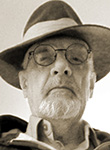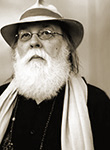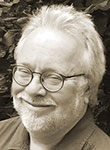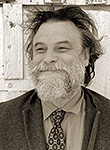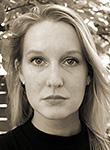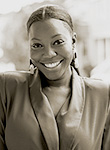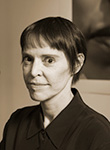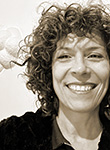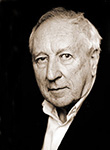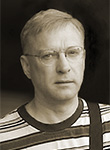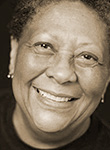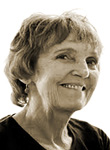Recommendations, Community, and Remembrance
Mary Flinn
Welcome to Blackbird’s In Previous Issues. Here we call your attention to work in our archives that for one reason or another has particular resonance against the work being newly published and/or the moment in which we are publishing. In addition, we will recognize work by old friends who are also current contributors and significant book-length material that we believe deserves steady and ongoing attention.
Again, sadly, we mark the passing of two former contributors, R.H.W. Dillard and Norman Dubie, both of whom were kind enough to lend us their presence in Blackbird’s early days as we were trying to establish our voice and reputation.
Blackbird first published R.H.W. Dillard in v2n1 with the essay “Going Out Into the Crazy: Some Thoughts About Real Writing and Real Reading,” in which he insists that
although love may not be all you need, any “real writer” or “real reader” does need love to bring the poem or story or novel or play to life.”
As well as other work scattered through our history, Blackbird published ten poems from Dillard’s penultimate book, What Is Owed the Dead in v5n1. Commenting on the book in an interview with his alter ego Sean Siobham in v10n2, Dillard tells us:
What Is Owed the Dead (and, by the way, I’m indebted for that title to a poem by Geoffrey Hill, who is very much not dead) is a sequence of fifty-two poems, each sixteen lines long, each addressed to a dead poet or several times to more than one dead poet . . . It is in one sense an effort to repay those poets for the gift of their poems, although many of the poets to whom I owe the most do not appear in the sequence, while others do. . . . And finally, the debt is owed to all of our predecessors, all of our dead poets, or, if I were more of a Platonist and less a radical empiricist and believed that there were such a thing, to poetry itself.
Below you will find a link to much of Norman Dubie’s work published in Blackbird, particularly to “The Spirit Tablets at Goa Lake,” a book-length futurist poem.
As Gregory Donovan says of him in Blackbird’s In Memoriam:
All along he exhibited a tremendous power of imagination that fueled the vivid, striking imagery of his poems and created the impression that he was able to cross all boundaries of time and space to gather his materials directly from the source. He lived in a modest apartment in Tempe that he had turned into a kind of temple filled with Buddhist icons and sacred objects, a sanctuary where he meditated daily and wrote prodigiously . . . The editors of Blackbird remember Norman Dubie with admiration and gratitude and recommend his writing to you with great pleasure and a joy whose only note of sadness is the regret that he will not be offering us more of his astonishing poems.
The eighth annual Claudia Emerson Reading Loop features Emerson’s poems “Piano Fire” and “Stringed Instrument Collection,” an essay by poet A.E. Stallings, Brad Efford writing on his personal relationship with Emerson and their shared appreciation for musician Lucinda Williams, and a series of photos that further illustrate Emerson’s connection to music. Blackbird’s relationship with Claudia Emerson’s work began in v1n2 with a review of Pinion, her second book. Four poems from the Pulitzer Prize–winning collection Late Wife appeared in v2n1. Other Blackbird appearances include the title poems for Secure the Shadow in v9n1 and The Opposite House in v12n1. These poems enable us to hear her voice and recall her presence.
In this issue, David Wojahn contributes another of his essays on
poetry—this time considering the work of poet Robert Hayden. Essays published previously include: “Ferocious Lullaby: Notes on Poetry and Parenting,” “‘On Hearing That My Poems Were Being Studied in a Distant Place’: Thoughts on Distance, Difficulty, and Secret Addressees,” and “Unlikely Magic (on Airmail: The Letters of Robert Bly and Tomas Tranströmer).” Wojahn has also been unfailingly generous with his own poems, most notably with “Ochre” which was presented as a suite of twenty-five poems with accompanying images in v9n2. Wojahn’s thoughtful kindness and advice have been tremendously valuable through the years, and we offer him our deepest and most sincere thanks.
Blackbird’s relationship with Steve Scafidi’s Lincoln project began in v11n2 with five poems and a reading, and Scafidi himself first appeared in the journal in v1n2 with poems and an interview. Musing on poetry with inquisitor Leslie Shiel, Scafidi, commenting on how to shape a book of poems, told us:
. . . a nice way to begin a book, talking about just the way these words have come to me, and they come slowly, tenderly, tangibly, shy and meanderingly, like something wild, but we never think of wild things like that. But that is often the wild things I see, that’s how they move, a possum, deer, raccoon, that’s how things move around around us out there, and it seems when I think of nature and when I think of the divine, and if I’m ever able to think about those things with any clarity, I think of those things the way I think about the wild . . .
Corey Van Landingham came to us first in v12n1 with poems that were included in that issue’s Introductions Loop. In her contribution to Tracking the Muse she wrote:
Meaning is a scary word to me, and something I fight constantly while creating. . . . Then it turns on me, starts running after everything I find beautiful and frightening, chases after my dead father, my failed relationships, my landscapes I keep hidden within me, and it rips into them. That beast—it makes such lovely bone piles.
In “At a Stranger’s Funeral” in v16n1, Zoë Gadegbeku introduced a protagonist ambushed by a grief that had booted her out of the regular rhythm of time that we expect to anchor a reality we trust. Her story in this issue revisits some of the same concerns.
Elizabeth King’s “Clockwork Prayer: A Sixteenth-Century Mechanical Monk” appeared in v1n1, which is where Isaac Lee found it when he was researching clocks and automata during the pandemic-imposed isolation. “The Most Ingenious Artist: An Internet Adventure from the COVID Lockdown,” his resulting essay, can be found in Nonfiction.
King’s piece is also the starting point for the expanded Miracles and Machines: A Sixteenth-Century Automaton and Its Legend, which King coauthored with W. David Todd and which includes photographs by Rosamond Purcell. The book is scheduled to be available from Getty Publications in August 2023. In v20n1, King pays homage to a friend and fellow artist in “Eleanor Rufty: The Moment Between Moments.”
Janet Peery first appeared in Blackbird in v4n2 with the short story, “How Beautiful Thy Feet With Shoes.” This story was later published as the prologue for What the Thunder Said (St. Martin’s Press, 2007), a series of linked stories and a novella. Blackbird senior editor Mary Flinn interviewed Peery about What the Thunder Said for the v6n2 issue, and Peery returned to Blackbird with her short story, “The Accident” in v16n1.
Artist George Ferrandi’s initial appearance in Blackbird occurred in v4n2 with “Superhero, Sidekick, Gaggle of Ghosts,” of which Ferrandi wrote: “Something about this is like reading and writing a book at the same time.” Other work by Ferrandi in Blackbird includes her extensive documentation and presentation of “The Prosthetics of Joy” in v13n1. As she stated of the piece:
. . . this project toys with the huge gaps between the second, third and fourth dimensions. Through its elaborate and complicated process, it also speaks to the desire and the difficulty for us as adults to experience the unself-conscious and spontaneous joy that children can; it speaks as well to the elusive question of what happiness is actually supposed to look like.
~
Serial Publications in Blackbird
Blackbird has published four full-length books in our pages, and they are listed here.
Early on, Blackbird presented the entirety of Norman Dubie’s “The Spirit Tablets at Goa Lake,” a book-length futurist poem. The poem was issued serially in three parts, beginning with the “Book of the Jewel Worm” in v1n2. It was followed by the other two sections, “Book of the Jaspers” and “The Book of Crying Kanglings,” in v2n1 and v2n2, as well as a helpful introduction and glossary. As Dubie states in a note to the piece:
This futurist poem enjoys the broken narration of its hero, Paul Ekajati, an amateur mathematician who once taught the Calculus on our moon. He is now an exhausted buddhist Vajramaster living in a small village at the Bakavi Lake Mining Colony on Mars. The year is 2277. Yeshe Khandro is in her last black ovum. Or, I should say that a raised mischievous voice in the poem belongs to a dakini “wisdom traveler in space” and that she is the destroyer of the Vega Remnant, LXT. There are eleven spirit tablets.
Additional work by Dubie includes five poems in v7n1, seven poems in v10n1, four poems in v11n2, three poems in v12n2, one poem in v13n2, and one poem in v15n1.
Nobel Prize-winning author Tomas Tranströmer’s 1996 book Sorgegond olen (Sorrow Gondola), in a new translation by Patty Crane and accompanied by the original Swedish, was published in Blackbird v10n1. To accompany the new translation Jean Valentine provided a letter to the Nobel laureate and David Wojahn presented a compelling meditation on literary friendship and correspondence in “Unlikely Magic, (on Airmail: The Letters of Robert Bly and Tomas Tranströmer).” There, Wojahn states, “The great subject of the poetry of Tomas Tranströmer—sometimes it seems as though it is his only subject—is liminality. He is a poet almost helplessly drawn to enter and inhabit those in-between states that form the borderlines between waking and sleeping, the conscious and the unconscious, ecstasy and terror, the public self and the interior self. Again and again his poems allude to border checkpoints, boundaries, crossroads: they teeter upon thresholds of every sort—be they the brink of sleep or the brink of death, a door about to open or a door about to close.” In v19n1, Blackbird published six new Crane translations of Tranströmer poems.
Since Wesley Gibson’s death in December 2016, Blackbird has contemplated ways to ensure his literary voice maintains a presence in the world. With that end in mind, we have reproduced his book, You Are Here: A Memoir of Arrival, which appeared in 2004 from Back Bay Books. The book, in part, is an account of Gibson’s witness to the HIV/AIDS crisis and its effects in New York City. Hailed at the time by Mary Gaitskill as “dark and sparkling, wonderfully intelligent, flip, and deeply felt,” You Are Here affords an excellent vehicle for honoring Gibson’s many strengths as a writer and his generosity of spirit as a friend. The first installment appeared in v17n1, and the text continues through v18n1, v18n2, v19n1, v19n2, v20n1, v20n2, v21n1, and v21n2. A review of You Are Here and a reading by Gibson were published in v3n1. His story, “The Raccoon,” appeared in v10n2.
Marilyn Nelson has for many years celebrated her friendship with Danish writer Inge Pedersen by translating her work, thus making it more available to the Anglophone world. Nelson’s translations of poems from Pedersen’s Den trettende måned appeared in Blackbird v1n1. Her translation of “Clouds and Fire Engines,” an excerpt from Pedersen’s last novel, The Path Leads Through the Air, appeared in v18n1, followed by “The Apple” in v18n2, “Seedings” in v19n1, “Mail” in v19n2, “That’s How It Goes Here” in v20n1, “Putting a Letter in the Mailbox” in v20n2, “I Said Nothing” in v21n1, and “Breathing Technique,” in v21n2. Nelson herself is the author and translator of more than twenty books of poetry for both children and adults. ![]()
Contributor photos link to an index of previous work in Blackbird.
